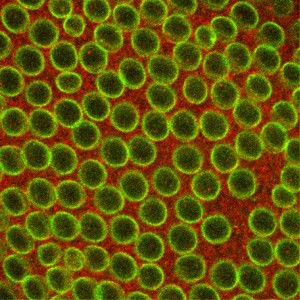Researchers explore the shift from maternal genes to the embryo’s genes during development
By Catherine Zandonella, Office of the Dean for Research

A new study from Princeton University researchers sheds light on the handing over of genetic control from mother to offspring early in development. Learning how organisms manage this transition could help researchers understand larger questions about how embryos regulate cell division and differentiation into new types of cells.
The study, published in the March 12 issue of the journal Cell, provides new insight into the mechanism for this genetic hand-off, which happens within hours of fertilization, when the newly fertilized egg is called a zygote.
“At the beginning, everything the embryo needs to survive is provided by mom, but eventually that stuff runs out, and the embryo needs to start making its own proteins and cellular machinery,” said Princeton postdoctoral researcher in the Department of Molecular Biology and first author Shelby Blythe. “We wanted to find out what controls that transition.”
Blythe conducted the study with senior author Eric Wieschaus, Princeton’s Squibb Professor in Molecular Biology, Professor of Molecular Biology and the Lewis-Sigler Institute for Integrative Genomics, a Howard Hughes Medical Institute investigator, and a Nobel laureate in physiology or medicine.
Researchers have known that in most animals, a newly fertilized egg cell divides rapidly, producing exact copies of itself using gene products supplied by the mother. After a short while, this rapid cell division pauses, and when it restarts, the embryonic DNA takes control and the cells divide much more slowly, differentiating into new cell types that are needed for the body’s organs and systems.
To find out what controls this maternal to zygotic transition, also called the midblastula transition (MBT), Blythe conducted experiments in the fruit fly Drosophila melanogaster, which has long served as a model for development in higher organisms including humans.
These experiments revealed that the slower cell division is a consequence of an upswing in DNA errors after the embryo’s genes take over. Cell division slows down because the cell’s DNA-copying machinery has to stop and wait until the damage is repaired.
Blythe found that it wasn’t the overall amount of embryonic DNA that caused this increase in errors. Instead, his experiments indicated that the high error rate was due to molecules that bind to DNA to activate the reading, or “transcription,” of the genes. These molecules stick to the DNA strands at thousands of sites and prevent the DNA copying machinery from working properly.
To discover this link between DNA errors and slower cell replication, Blythe used genetic techniques to create Drosophila embryos that were unable to repair DNA damage and typically died shortly after beginning to use their own genes. He then blocked the molecules that initiate the process of transcription of the zygotic genes, and found that the embryos survived, indicating that these molecules that bind to the DNA strands, called transcription factors, were triggering the DNA damage. He also discovered that a protein involved in responding to DNA damage, called Replication Protein A (RPA), appeared near the locations where DNA transcription was being initiated. “This provided evidence that the process of awakening the embryo’s genome is deleterious for DNA replication,” he said.
The study also demonstrates a mechanism by which the developing embryo ensures that cell division happens at a pace that is slow enough to allow the repair of damage to DNA during the switchover from maternal to zygotic gene expression. “For the first time we have a mechanistic foothold on how this process works,” Blythe said.
The work also enables researchers to explore larger questions of how embryos regulate DNA replication and transcription. “This study allows us to think about the idea that the ‘character’ of the DNA before and after the MBT has something to do with the DNA acquiring the architectural features of chromatin [the mix of DNA and proteins that make up chromosomes] that allow us to point to a spot and say ‘this is a gene’ and ‘this is not a gene’,” Blythe said. “Many of these features are indeed absent early in embryogenesis, and we suspect that the absence of these features is what allows the rapid copying of the DNA template early on. Part of what is so exciting about this is that early embryos may represent one of the only times when this chromatin architecture is missing or ‘blank’. Additionally, these early embryos allow us to study how the cell builds and installs these features that are so essential to the fundamental processes of cell biology.”
This work was supported in part by grant 5R37HD15587 from the Eunice Kennedy Shriver National Institute of Child Health and Human Development.
Blythe, Shelby A. & Eric R. Wieschaus. Zygotic Genome Activation Triggers the DNA Replication Checkpoint at the Midblastula Transition. Cell. Published online on March 5, 2015. doi:10.1016/j.cell.2015.01.050. http://www.sciencedirect.com/science/article/pii/S0092867415001282

You must be logged in to post a comment.